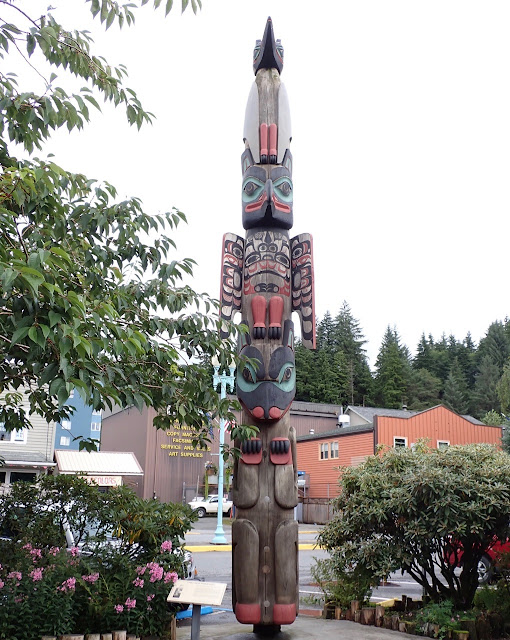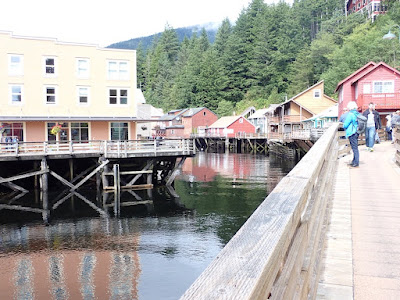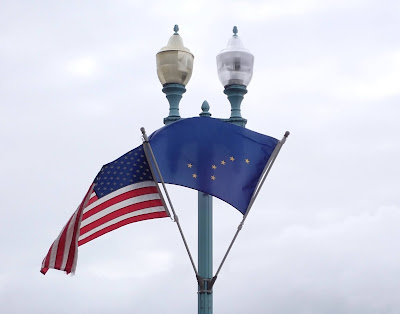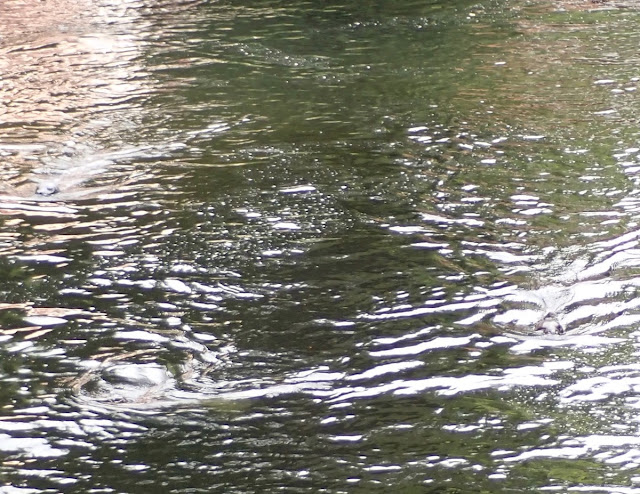October 6, 2021
 We left our hero and heroine (Richard and Phebe) travelling through Alaska while cruising those frozen waters. Then life got busy, and I didn't make it to posting the end of the cruise, nor what was happening next in our lives.
We left our hero and heroine (Richard and Phebe) travelling through Alaska while cruising those frozen waters. Then life got busy, and I didn't make it to posting the end of the cruise, nor what was happening next in our lives.
 My apologies. Life often gets in the way of doing things like writing this blog.
My apologies. Life often gets in the way of doing things like writing this blog.
In reality, we're now in Tucson, Arizona. No, we're not exploring all the states that begin with the letter A. We are, however, finding creative ways to travel within the US during these pandemic years.  We've rented a little house in Tucson for seven months, and will winter over here. We drove from Bellingham, WA, to Tucson, and of course managed to have adventures along the way.
We've rented a little house in Tucson for seven months, and will winter over here. We drove from Bellingham, WA, to Tucson, and of course managed to have adventures along the way.
But those are other stories to tell, and other blogs to write. So, let's return to our hero and heroine, and  finish their exciting cruise through the inside passage, in and around the Alaskan panhandle.
finish their exciting cruise through the inside passage, in and around the Alaskan panhandle.
Our last port of call was Ketchikan. Ketchikan is just barely smaller in population than Sitka, but Sitka is more spread out geographically. So Ketchikan feels more densely populated, and more city-like. Sitka had more of a town feel.
I didn't have a
plan, nor did I sign up for a tour or excursion. I just wandered around
downtown Ketchikan, seeing the buildings, the art, and even a few
animals.
Ketchikan is
located at the southern entrance to the inside passage, meaning the
waterway in and among the various islands of the panhandle. It makes
for tricky navigating, but it also is smoother sailing that out in the
ocean - especially in any kind of stormy weather.
 As with many Alaskan port towns and cities, Ketchikan built up around the fishing and canning industries. Many of the waste cans around the city today are designed to look like the original cans of salmon produced here, with the old labels printed on the waste cans. Occasional walls boast a
As with many Alaskan port towns and cities, Ketchikan built up around the fishing and canning industries. Many of the waste cans around the city today are designed to look like the original cans of salmon produced here, with the old labels printed on the waste cans. Occasional walls boast a  replica canned salmon label as well.
replica canned salmon label as well.
In one park, the wood benches were designed to look like ocean creatures: diving dolphins, whales and their tales. I even saw a bus painted with frolicking fish!!! Yes, we definitely were in the land of ocean animals! But seriously, it does make sense - the economy was based on the industries that developed around the environment. This environment is rich in ocean fish, especially salmon and halibut. Well, and king crab. Salmon was easily canned, and the demand for it grew. So indigenous art as well as the art of the people who moved here revolved around that environment and the industries. Fish, fishing. It's pretty basic.
I walked around the dock area, looking at various boats. Nothing very exciting. The most exciting were two Tlingit figurines atop tall posts - one, I think, is Frog, based on the body. Yes, it doesn't have a frog mouth given that it has all those teeth. But the Frog clan is important, and the body of this animal looked more like a frog or toad than anything else.
The other is either Raven or Eagle, and I tend to mix them up unless I see them together. I think Eagle's beak usually is more curved at the end, so that would mean this is more likely Raven. And carrying a fake gem stone seems more like something Raven would do, rather than Eagle. Eagle isn't distracted by shiny baubles.
Speaking of the environment shaping the art of a region, have you seen the Alaskan flag? Yes, that's the Big Dipper on it! Or Ursa Major, the Bear, depending on which name you prefer. (And the North Star, Polaris, is also included.) Given that Alaska is known for its bears, plus the northernmost US state,  this makes perfect sense. Definitely a great state flag design!
this makes perfect sense. Definitely a great state flag design!
I encountered a variety of totem poles as I wandered. This first totem pole is the Chief Kyan Totem Pole, and the following information is from the info placard posted next to the totem pole.
"Totem poles are carved to  honor deceased ancestors, record history, social events, and oral tradition. They were never worshipped as religious objects.
honor deceased ancestors, record history, social events, and oral tradition. They were never worshipped as religious objects.
"The totem is the second replication of the Chief Kyan Totem Pole. The original pole was carved in Ketchikan in the early part of the century and stood in Barney Way until the late 1920s, when it was moved to the Pioneer Hall. In 1964, the aged pole was removed and replicated for the first time. The second replication was commissioned by the City of  Ketchikan, to Tlingit master carver Israel Shotridge, who is a member of the Tongass Tribe. The pole was carved during the summer of 1992, with the assistance of apprentice Edwin DeWitt. Rededication and poleraising was on July 3, 1993.
Ketchikan, to Tlingit master carver Israel Shotridge, who is a member of the Tongass Tribe. The pole was carved during the summer of 1992, with the assistance of apprentice Edwin DeWitt. Rededication and poleraising was on July 3, 1993.
"The figures on the pole represent the Crane, the Thunderbird, and the Brown Bear. The original pole belonged to Tongass Tlingit Chief George Kyan whose Brown Bean crest can be seen on the pole. Chief Kyan's Tlingit name was Yaansein. He was of the Wolf clan and was a member of the Tantakwaan tribe."
 I try to always get a photo of the full totem pole, and then close up photos of the different
I try to always get a photo of the full totem pole, and then close up photos of the different  components of the pole, so we can see each totem or animal figure in greater detail.
components of the pole, so we can see each totem or animal figure in greater detail.
 The Chief Johnson Totem Pole was the second one I encountered, and it was interesting because it was extra long due to a long long pole holding up the bird on the top. And this totem pole is 55 feet tall!!! (About 18 meters!) The info sign said that this "undecorated space is a symbol of the lofty
The Chief Johnson Totem Pole was the second one I encountered, and it was interesting because it was extra long due to a long long pole holding up the bird on the top. And this totem pole is 55 feet tall!!! (About 18 meters!) The info sign said that this "undecorated space is a symbol of the lofty 
 habitat and high regard in which the crest [Kajuk, the fabled bird] is held.
habitat and high regard in which the crest [Kajuk, the fabled bird] is held.
The sign repeats the information  that totem poles are carved to honor deceased ancestors, record history and oral tradition, and mark social events. That they were never worshipped as religious objects.
that totem poles are carved to honor deceased ancestors, record history and oral tradition, and mark social events. That they were never worshipped as religious objects.
The sign goes on to say:
 "This totem, carved by Israel Shotridge and raised in 1989, is a replica of the Chief Johnson, or Kajuk, Totem Pole raised in this general location in 1901 for the Ganaxadi Tlingit of the Raven moiety of the Tanta Dwan (Tongass) group. The original memorial pole stood until 1982.
"This totem, carved by Israel Shotridge and raised in 1989, is a replica of the Chief Johnson, or Kajuk, Totem Pole raised in this general location in 1901 for the Ganaxadi Tlingit of the Raven moiety of the Tanta Dwan (Tongass) group. The original memorial pole stood until 1982.
"Except for Kajuk atop the pole, the figures symbolize a single story about Raven. Fog Women is identified with the summer salmon run when fog lies at the mouth of the  streams. She produces all salmon and causes them to return to the creeks of their birth."
streams. She produces all salmon and causes them to return to the creeks of their birth."
Note: Kajuk, the figure on the very top, is a fabled bird.
After those two totem poles, I continued in my  wandering and met a young raven who was standing along the shore. I think this is where Creek Street flows out to the sea water, and my raven friend was drinking the fresh water (which often floats on top of sea water close to shore).
wandering and met a young raven who was standing along the shore. I think this is where Creek Street flows out to the sea water, and my raven friend was drinking the fresh water (which often floats on top of sea water close to shore).
Creek Street. Somewhere  as Ketchikan grew, raised wood sidewalks or boardwalks were built along the banks of the Ketchikan Creek, and Creek Street was born. This actually was originally the red light district of Ketchikan, and you can visit some of the old historic brothels - not being used in their original format, no, now a historic
as Ketchikan grew, raised wood sidewalks or boardwalks were built along the banks of the Ketchikan Creek, and Creek Street was born. This actually was originally the red light district of Ketchikan, and you can visit some of the old historic brothels - not being used in their original format, no, now a historic  tourist place to explore. There are also art galleries and shops, and it's fun to walk along the boardwalks.
tourist place to explore. There are also art galleries and shops, and it's fun to walk along the boardwalks.
There were even a few seals (or sea lions?) playing in the creek! (One has visible ears, one does not, and I never remember which is which.)
If you don't see the seals/sea lions in the photos below, look for dark little faces in the dark water. There were three of them swimming and diving in there!
There's a walkway down to the creek, and at the base is the sculpture "Yeltatzie Salmon" by Terry Pyles. This sculpture was named in honor of Haida Native carver Jones Yeltatzie (1900-1976). Yeltatzie carved a wood salmon sculpture that was originally located on this same site, but this piece created in his honor has replaced that salmon.
 The last totem pole I encountered is "Raven Stealing the Sun." This totem pole was commissioned by the City of Ketchikan, and "honors the Tongass Tlingit people who historically inhabited the local area. Dempsey Bob and Stanley Bevan designed and carved the pole which was raised in 1983.
The last totem pole I encountered is "Raven Stealing the Sun." This totem pole was commissioned by the City of Ketchikan, and "honors the Tongass Tlingit people who historically inhabited the local area. Dempsey Bob and Stanley Bevan designed and carved the pole which was raised in 1983.
 "The totem tells of Raven who desigred the sun, moon, and stars owned by a powerful chief. Raven changed form, appearing as the Chief's grandson, and cried until his grandfather gave him the boxes containing the heavenly bodies. Then Raven, with his trickery, opened the boxes, bringing stars, moon, and sun to the Earth."
"The totem tells of Raven who desigred the sun, moon, and stars owned by a powerful chief. Raven changed form, appearing as the Chief's grandson, and cried until his grandfather gave him the boxes containing the heavenly bodies. Then Raven, with his trickery, opened the boxes, bringing stars, moon, and sun to the Earth."
Isn't that a great story? I love traditional myths and oral traditions that explain how the world and our universe were formed. Raven seems so integral to the Tlingit stories of human origins. Maybe these are explained by the was ravens often seem to keep an eye on humans, likely just hoping for food, but in some ways seeming to be our protectors.
The bottom figure is the chief who originally owned the sun, moon, and stars.
The baby's face sitting above the chief's head suggests the chief's Raven-ness (at least according to the info sign).
Above the baby's face is the chief's daughter.
Above the daughter is the sun.
 And on the top of the totem pole is Raven, the trickster.
And on the top of the totem pole is Raven, the trickster.
Of course, there is much more to see in Ketchikan - people went out to fish, or do more whale watching cruises, or even to  a bear rescue sanctuary. Other people went to sled dog summer camp, where the huskies stay in shape by pulling sleds on wheels. (That excursion includes time playing with the sled dog puppies, which was very tempting. I mean, seriously, can you imagine an afternoon spent playing with baby huskies? How adorable is that!)
a bear rescue sanctuary. Other people went to sled dog summer camp, where the huskies stay in shape by pulling sleds on wheels. (That excursion includes time playing with the sled dog puppies, which was very tempting. I mean, seriously, can you imagine an afternoon spent playing with baby huskies? How adorable is that!)
But I had fun exploring the old section of downtown Ketchikan, meeting some seals, and communing with my own young Raven.













I love this, so much detail and description, especially about the totem poles!
ReplyDeleteThis was such a fun read. I appreciate getting to travel virtually through y'all.
ReplyDeleteYes, baby huskies would have been very tempting -- but I think you got the most out of the Ketchikan stop by creating your own adventure, led on by your insatiable curiosity and keen observation. What a pretty town: love those salmon labels and the totem poles. I'll be viewing ravens with new appreciation!!
ReplyDeleteA fascinating tour! I love the benches and the totems... and who can resist those seals, as they progress through the water?
ReplyDeleteLoving the travel tales, and it doesn't matter that it takes a while to process and publish!
I love totem poles. One of our neighbors has one. The seals were so cute! We have ravens here who beg us for food every day.
ReplyDeleteThank you for sharing the information about the totem pole meanings.
ReplyDeleteWonderful blog.